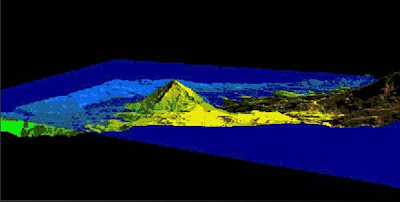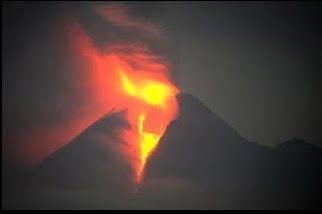Geomorphology is the one piece of geography. Where geomorphology which is a branch of geography, learning about the shape of the earth, which includes a broad view of the scope of the appearance of the landscape (landscape) to the smallest unit as a form of land (landform).
Landform system consists of mountains, hills, volcanic, karst, Alluvial, until the Marine Plain is formed by the influence of the constituent rocks at the bottom layer of the earth's surface.
Observation and identification of landforms such as is done directly in the field by conducting field trips or can also be done with the interpretation of aerial photographs or Landsat Analysis (ACS). Remote sensing as a tool to monitor or observe objects without touching biumi face it directly, among other form of aerial photography or satellite imagery.
Landscape will be easily identified by sight distance or if using aerial photography or satellite imagery using a small-scale images. In contrast to the landscape easily observed at close range or with aerial photos or satellite imagery with a larger scale.
By observation and analysis of aerial photographs of land forms will other biophysical information obtained both as a fixed parameter (landform, rock, soil, slope) and the parameter changes (erosion, terrace, land use).
By doing fieldtrip will be more well known in the field of land forms, making it easy to remember it if ever seen in person and as a basis for memory at the time of aerial photo interpretation (IFU).
Forms of land even though easily observed by aerial photographs, but the approach needs to be done by doing come directly to the field in the form of field trips (field trip). It is intended to further ensure tersiri landform forming elements of the composition or arrangement of any rocks. Besides, the survey will be acquired lapangna fotro interpretation of several key air (IFU) of the results of field visits to various different land forms. So that would be obtained with IFU key analaisis a more complete form of land which is a constituent component of the landscape.
Complex form of the earth has become a subject of its own, especially in business usage. In this case any land formations have different capacities in an effort to support the use of which would lead to appropriate. So with the same goal which is intended to simplify the form of a complex land surface of this earth, then the understanding of the science of geomorphology to study land formations are very important.
Simplification of the complex face of the earth form a unit which has a similarity in the nature and perwatakannya. Unitary properties include geological or geomorphological structure similarity as the origin of its formation, geomorphological processes as giving information on how the land is formed, and topographical impression that will provide information about the configuration of the land surface. Given the information is appropriate land use planning will be further realized.
Until now the literature and maps on geomorphology Indonesia is still very little.
Existing maps, the area is very limited and small scale. While the map is
are needed as basic data to support development planning
a region.
Indonesia is currently only available in small-scale geomorphological map, which geomorphological map
Java by Pannekoek (1946) in the scale 1: 1,000,000. Then Verstappen
(1973), produced a geomorphological map of the island of Sumatra and the islands of the
surrounding the use of research utilizing image inderaan uh ja
a scale of 1: 2,500,000.
Several agencies in Indonesia, lately has been trying to make a map
geomorphology, but the emphasis the problem is still around generation (relief)
the earth's surface, while the process of its formation has not been disclosed in detail.
Since 1989, Center for Geology has mapped the geomorphology
using System ITC in 16 regions. Mapping resulted in 16 pieces
geomorphological map of the whole has been published in the scale 1: 100,000 (15 pieces)
and scale 1: 50,000 (1 sheet).
Given the above, the standard preparation of maps Geomorphology
is structured to generate a standard geomorphological map (default). System (method)
compilation system of ITC (International Institute for Aerospace Survey and
Earth Sciences) with a reference book entitled "Aerial Photo-Interpretation in
Terrain Analysis and Geomorphologic Mapping "(Van Zuidam, 1985). ITC system
selected and used as reference considering this system is a combination of
some existing systems, both in tropical, sub tropical, dry and slightly dry.
In the preparation of maps of geomorphology, the use and appearance factors need to be
consider, among other things:
a. Can be used for various types of terrain and flexible.
b. Can be used dlam various ways.
c. Simple and informative.
Intent and purpose of standardizing the preparation of maps of geomorphology is as
guidance in preparing geomorphological maps in Indonesia.
Prepared taking into account aspects of the terminology is often used in
maps and has a very distinctive name arranged alphabetically.
Landscape (landscape)
scenery composed by geomorphological elements in dimension
a wider range of terrain.
Forms of land (landform)
physical complex surface or near surface of the land
influenced by human activities.
Formation origin (morphologic origin)
landscape formation based on the genesis (mulajadi).
Denudation (denudation)
the process of stripping the earth's surface of the lid.
Geomorphological elements (geomorphologic element)
the smallest piece of land that have the same shape and form
genesanya.
Erosion (erosion)
series of processes that lead to a number of earth or rock material
eroded, transported and relocated elsewhere in the earth's surface.
Fluvial (fluvial)
activities that cause stream erosion, transport and
deposition of material on the surface of the earth.
Style endogenous (endogenous force)
power comes from within the earth that caused the movement,
fault, and vulkanisma perlipatan in the earth's surface.
Style exogenous (exogenous force)
energy from the outside world which leads to changes in
surface or near the earth's surface, such as weathering, erosion, abrasion, denudation.
Geomorphology (geomorphology)
is the science of the earth and its novel aspects
influence it.
Hogbek (hogkback)
ridge of hills or mountains with sharp peaks formed by
rock layers are hard and steep slopes.
Kars (karst)
shape the landscape caused by the intensification of the process of dissolving rock
limestone to form a distinctive landscape.
Kuesta (Cuesta)
hill or mountain that has two different slopes. Surface
slope of the ramps in line with the bedding area while the slopes
steep cut the bedding area.
Marin (marine)
activity of sea water which can cause abrasion, transport and
deposition in the marine environment.
Mesa (mesa)
isolated hill or mountain-shaped table, with the rest of the denudation
layers of flat rock hard as the lid.
Morfodinamis (morphodynamics)
landscape forms are strongly associated with the work style of exogenous water,
wind, ice and ground motion, eg sand dunes, river terraces, coastal embankment,
critical lands (Badlands).
Morfoerasi (morphoerosion)
are various forms of erosion that can be used as a measure of the degree of degradation
landform of an area.
Morfogenesa (morphogenesis)
landscape forms are classified based on mulajadi (genetic)
and development of landforms and the processes that happen to him.
Morphology (morphology)
the study of the shape the earth's surface.
Morfokonservasi (morphoconservation)
preservation of natural land forms based on the parameters.
Morfokronologi (morphochronology)
ties variety of land forms and processes.
Morphometry (morphometry)
quantitative aspects of the geomorphology of an area, eg, slope steepness, height,
terrain roughness.
Morfografi (morphography)
diskriptik geomorphological aspects of an area, eg, plains, hills, mountains,
plateau.
Morfostruktur active (active morphostructure)
landscape forms are strongly associated with the work style of the endogenous
dynamic, including volcanoes, tectonic (folds and faults), eg volcanoes,
ridge anticline and fault escarpment.
Morfostruktur passive (passive morphostructure)
form a landscape that is classified on the basis of rock type and structure
rocks that are related to denudation, eg mesa, kuesta, hogbek, and
dome.
Weathering (weathering)
the destruction of rock or mineral surface of the earth become a more
small or soft because of the physics, chemistry and biology.
Sectional geomorphology (geomorphologic cross section)
was sliced up that reflect the landform configuration
landscape.
Land cover (land cover)
Anything that covers the surface of the earth, either natural or artificial.
Terrain (terrain)
form of surface or near the earth's surface that have physical characteristics
particular.
























